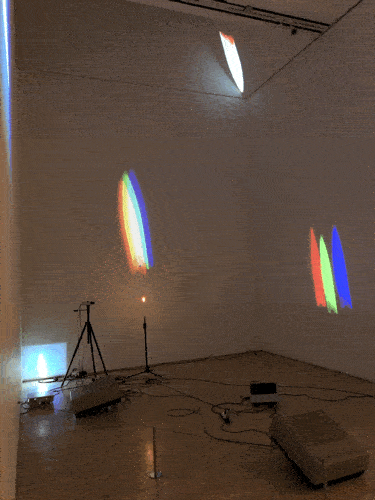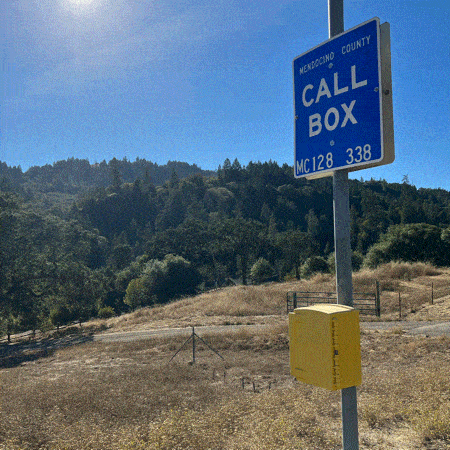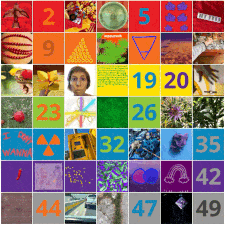Year 5, Piece Thirty-Six: 31. Blue Yellow
The digital is domestic. Emergency calls on the electronic superhighway.
Blue Yellow is Communication Power. Perhaps appropriately, Mercury is retrograde again, purportedly interfering with communication and technology. Yellow is also electricity, so Blue Yellow could specifically be electronic communications. Interference from and to electronic communications certainly dominated the news this week.
Also appropriately, I went last week to see the Nam June Paik retrospective at SFMOMA before it closed. Paik coined the term “electronic superhighway” in the 1970s to describe the future of global communications, and, well, here we are. Paik was the founder of video art, a classically trained musician, a member of Fluxus, and a prolific collaborator, so this show featured over 200+ artworks. Television sets in so many states of assembly and disassembly and reassembly: broken open, manipulated by magnets, stacked as sculptures, turned into cellos, turned into bras, heaped en masse playing psychedelic video mash-ups of digitally manipulated musical performances on repeat. A couple of works incorporated a live candle lit inside the gallery each day, like this one:

Beyond manipulating hardware, Paik also created and broadcast content. Good Morning, Mr. Orwell was his first live satellite broadcast on New Year’s Day 1984, a rebuttal to George Orwell’s dystopian predictions for that year. A mash-up of live events happening simultaneously in New York and Paris, Good Morning, Mr. Orwell was an intentionally chaotic variety show of high art and 80s pop performers from John Cage, Merce Cunningham, Joseph Beuys, Allen Ginsberg, and Laurie Anderson to Peter Gabriel, the Thompson Twins, and Oingo Boingo, seen through Paik’s computer graphic filters. This satellite broadcast was designed to transcend geographical boundaries to reach your television set, simultaneously reaching others in their own homes across the world. SFMOMA projected this and another of Paik’s broadcasts, Bye Bye Kipling, back to back in a darkened room with a couple benches. Still, they nodded towards its original medium of transmission by choosing screen the pieces at specific times as opposed to a continuous loop. At more than half an hour each, this made for only 7 minutes of dead air between each showing, but it was some curatorially significant dead air.
Going to see this show was a sort of pilgrimage, both to pay respects to this father of digital art as well as to reestablish my own commitment to Fine Art: my first time being alone at a museum in I don’t know how many years. My mental map of SFMOMA still includes the best benches for nursing and all the places you can secret away with a screaming baby (tip: in times of crisis, you can lock yourself into the family bathroom on the second floor. It’s painted bright red on its walls, floor, and ceiling, which strangely acts as a sort of sensory deprivation tank). But this time instead of paying attention to the facilities, I paid attention to the art, wandering the rooms at my own pace and reading every piece of wall text I encountered. It was glorious.
But that much art at once was also maybe too much. After a while I found myself almost out of control, walking and looking and reading and walking and looking and reading not unlike I might scroll on my phone, needing to pee and needing to eat and needing to leave but not being able to stop. This compulsive viewing even followed me into the gift shop, where I moved my body from books to postcards to housewares to jewelry to tchotchkes looking and looking and looking with absolutely no intention to buy but browsing ceaselessly nonetheless. Years of social media scrolling on my phone has trained my dopamine receptors to keep repeating the same passive activity for the next and next and next hit. The sheer volume of content at the museum acted as a physical manifestation of Paik’s prognostications about telecommunications.
Maybe it was experiencing the physical world through a digital mindset, but in my zombie state I had a revelation about my own work. I’ve struggled with how and whether I would want Rainbow Squared exhibited in a gallery setting. I mean, it could be pretty straightforward: a projector playing this 7x7 html grid, even updating live to add a new piece whenever its created. But what about all the text? And what about showing individual pieces instead? And would the viewer be able to choose which piece they viewed or would they play in a single-channel loop? And would it be work from one particular year, or all five? What about future iterations with more collaborators? What about crawling the internet live for every instance of #redred or #redorange or #redyellow?
There are so many ways I could physically represent this work, but what I realized is that there is a fundamental difference between a projection in a gallery and a digital work in its native habitat. And in 2021, a digital work’s native habitat is a personal device, wherever the viewer happens to be. Whether you are experiencing it on a phone or on a computer or on a billboard, whether you are behind a desk or behind a counter or on a bus, the multiplicity of contexts for experiencing digital work is itself a context.
This project, Rainbow Squared, was born out of a situational exclusion from the Art World, that exclusion being early parenthood, and specifically early motherhood. Recently a couple artists mothers whose children are grown told me about how those early days temporarily changed the scope of their work. They turned to what they had on hand and what they could do in those in-between moments, working on a more intimate scale with more intimate subject matter. I could of course relate: the confines of motherhood made my own practice autobiographical, and it also made it digital. My phone was a toolbox I always had on me, and my studio was (is?) wherever I happened to be. If my work became more domestic, it was a digital domesticity.
The digital communications sphere is a domestic sphere. It is also simultaneously a professional sphere, to be sure. There is a major context collapse here, that you can use the same devices and interfaces to interact with your mom or with your boss, and you can do both from the toilet. You may even be reading this sitting on the toilet. You may even be reading this sitting on the toilet in the middle of the work day. You may even be reading this in your own home sitting on the toilet in the middle of a work day. And that is very different from standing in a museum or a gallery.
The good news is that the digital world is in many ways more accessible than a museum. Beyond the pain in the ass of lugging children along, location and cost alone prohibit most people from ever setting foot in a museum, or art gallery for that matter. And for better or worse, my work in the domestically digital sphere has turned into word sculptures, essays that it makes the most sense for you to be reading in the intimacy of your inbox or web browser. So while one day I would love for you to experience some iteration of this work among crisp white walls, for right now it makes sense for you to be taking it in at your own pace, wherever you are. We are being super intimate, you and I. Or at least I’m being intimate with myself in a publicly-available format, simultaneously hoping and not hoping that anyone will read it.
Of course the digital is the primary realm for so much more art than just my own. There are more and more (and more) creatives out there whose work exists only online, and only in environments created by tech companies. Environments where the plug can be pulled at any moment, and briefly were this week. Our work and our interactions live in digital structures that seem to be unbiased purveyors of public content but are architected by others for their own ends. Not unlike museums, where it seems like the work on display is there by some objective classification of artistic value, but in fact is determined by a relatively specific cadre of people using the algorithm of historical bias. People determine which content is venerated or panned, what is seen and what fades into obscurity.
In its architecture of perhaps the world’s largest digital social infrastructure, Facebook Inc. has created a global state of communications emergency. That is why Frances Haugen is blowing the whistle, ringing the alarm bells, or—like a call box on the side of the electronic superhighway—ringing the emergency phone.
Remember how Blue Yellow is Communication Power? California highways are dotted with Call Boxes, poles with big blue signs atop yellow boxes with phones inside to call for help in case of an emergency. Blue Yellow bastions of salvation in times where things have gone wrong. I appreciated the permission that art gave me to get out of the car and look at one of these things outside of an actual crisis. Actually, I looked at a few of these things: we stopped three times on this 55 mile stretch of highway because I wanted to get the right shots, and my family is very understanding. Or resigned, anyway.
These call boxes are in some ways a relic of another time. But while pay phones are all but gone, there is still a need for these emergency boxes. That need is decreasing of course: according to Wikipedia, California made 98,000 calls from these boxes in 2001, which dropped 80% to 20,100 calls in 2010. Who knows how many that would be in 2021 when mobile phones are even more ubiquitous. Still, cellular reception is spotty up on those windy roads, and things happen on highways. And so there is real communication power in these boxes, the ability to signal to another human that something is wrong and to ostensibly get help. If only they could be used beyond roadside distress.

Wherever you are reading this, and especially if you are reading it in the beginning of October 2021, be kind to yourself as the planets do their thing (if that’s your thing). Six are retrograde right now: Mercury, Jupiter, Saturn, Uranus, Neptune, and Pluto. We just had a new moon in Libra, the same sign that the communications planet of Mercury is in. The new moon also means a new Hebrew month: Cheshvan, the one Hebrew month with no holidays. For me, this is a relief. This new moon I dusted and rearranged my altar, which was quite overdue. I also packed away my shofar, itself an emergency call box of sorts. And certainly a communication technology, if an ancient one. I am grateful for the coming silence.






Brilliantly sew together!
This post in particular just caught my attention because of the way you were connecting things — those unexpected associations!